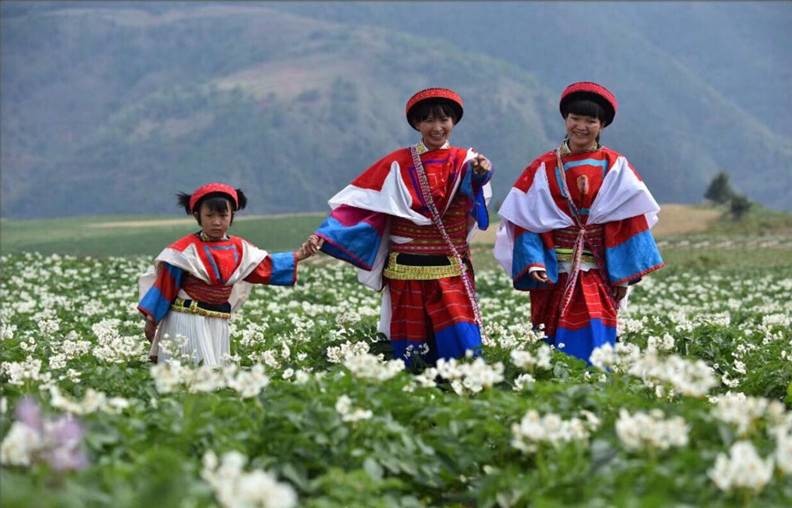 alt="Market Days in Xuanwei City and Townships, Qujing"
/>
alt="Market Days in Xuanwei City and Townships, Qujing"
/>
Liushao Town Travel in Xundian County, Kunming
Liushao Red Earth/六哨红土地
Liushao Red Earth, compared to Dongchuan Red Earth, has its own unique characteristics, with an even larger geographic area that includes gently sloping mountain roads running through it, making it particularly convenient for sightseeing and photography. Being in a high-altitude cold mountainous area, the autumn harvest here starts earlier than in Dongchuan. In July, walking along the mountain paths, one can feel the autumnal ambiance, with various wildflowers of the season blooming along the roadsides. Farmers busily harvest crops in the fields, with plump potatoes scattered across the red earth. Many fields have been plowed and sown, exposing more of the red soil, creating a vibrant and colorful landscape that is truly spectacular.
Liushao Township is located in the central-western part of Xundian County, about 120 kilometers from Kunming. It is a mountainous township inhabited by ethnic minorities, situated at an altitude of over 2000 meters. Traveling along the township’s roads, one can witness continuous terraced fields stretching across the mountains, reaching out towards the distant horizon, presenting a magnificent scene. Located in the Wumeng Mountain region, not far from Dongchuan, most photographers focus on Dongchuan Red Earth, leaving Liushao largely undeveloped as a tourist destination. Consequently, there are few visitors, yet it offers a serene and pristine environment cherished for its untouched beauty. For those seeking to capture the beauty of red earth landscapes, Liushao is certainly not to be missed.
Address: Most areas of Liushao Township, Xundian
Heihe Crane Nature Reserve/寻甸黑颈鹤自然保护区
The Xundian Heihe Crane Nature Reserve is known as the southernmost wintering ground for the Black-necked Crane and is the only place in Kunming where this nationally protected species can be observed. Located on the elevated plateau between Liushao, Diansha, and Jinshuo in the central-western part of Xundian County, the reserve hosts a large population of Black-necked Cranes every year from the 9th day of the 9th lunar month to the 3rd day of the 3rd lunar month. The reserve is 45 kilometers away from Xundian County town. In recent years, the reserve has strengthened conservation measures to maintain the population of Black-necked Cranes that migrate here for wintering. Additionally, Xundian has designated a wetland area within the core protection zone for cultivating crops such as potatoes and buckwheat to ensure food sources for the wintering Black-necked Cranes.
Tips: The Black-necked Crane is a large flying bird, approximately 120 centimeters in length, with a gray-white body. It is the only crane species in the world that breeds and thrives on plateaus. They inhabit grasslands and marshes at altitudes ranging from 2500 to 5000 meters, mainly found in China’s Qinghai-Tibet Plateau and Yunnan-Guizhou Plateau. They breed in the border areas of Qinghai, Gansu, and Sichuan, as well as in Xinjiang during the summer, and migrate to southern Tibet and the Yunnan-Guizhou Plateau for winter. Originally concentrated around Dashanbao in Zhaotong City, they have gradually migrated south in recent years, with increasing numbers seen annually in Yunnan’s Kunming Xundian County, Yuze County, and other areas.
Address: Henghe Village, Liushao Township, Xundian County
The Windmill Group of Liushao/六哨风车群
Near Henghe Village in Liushao Township, there is a picturesque windmill group standing tall on the red hillsides. Against the backdrop of colorful potato flowers reflecting off the red earth, these white windmills become a distinctive feature of the majestic landscapes of Wumeng.
The windmill group is located near Henghe Village, south of Liushao Township. There are signs along the road, and after traveling approximately two kilometers into Henghe Village, you can see them atop the village’s hills. While the potato flowers here may not be as spectacular as those in Baili Village or Dahutang Village, the addition of windmills creates a unique and charming scenery.
Address: Henghe Village, Liushao Township, Xundian County
Entrance Fee: Free
Yi Ethnicity Lichu Festival
The Torch Festival and Lichu Festival are the primary festivals of the Yi ethnic group, with the Lichu Festival being particularly celebrated in Xundian. Before liberation, the Torch Festival was Xundian’s most grand event, held annually from the 24th day of the 6th lunar month for three days. It involved ancestral worship and various entertainment activities such as bullfighting, wrestling, swings, horse riding, and archery.
The Lichu Festival evolved from the Torch Festival and is a festival where the Yi people pray for a bountiful harvest. It still occurs on the 24th day of the 6th lunar month, focusing on entertainment activities. It is said, “Han people have their stages, Yi people have their autumn stages,” highlighting the grandeur of the Lichu Festival. The main activities during the Lichu Festival include bullfighting, derived from earlier traditions of cricket, cock, and sheep fighting, along with wrestling, horse riding, archery, cultural performances, and trading activities.
To experience the unique atmosphere of the Yi Lichu Festival, consider visiting Liushao. In the autumn fields, the lively bullfights reach a climax amid the laughter and cheers of crowds; elegantly dressed Yi women in red attire and white pleated skirts gather in groups, their embroidered red shawls draped over their shoulders. Nearby, steam rises from large iron pots of mutton soup, emitting irresistible aromas. Under the shade of trees away from the crowd, Yi young men sing traditional songs with the young women.
Address: Town of Liushao, Xundian County
Date: 24th day of the 6th lunar month each year (corresponding to August 7th in 2015)
Accommodation: Several guesthouses are available in Liushao Township, typically priced around 50 RMB per room, rising to 70-80 RMB per room during the Lichu Festival.
Transportation: (40 km from Xundian County)
- Driving from Xundian County: Take the Sanyu Road to Jinsuo Town, then head towards Xianfeng/Majie direction at Jinsuo Town. Turn right towards Liushao at Longjiazi (look for signs for Yilin Garden and Qinglong Restaurant along the way). Follow the road until reaching Henghe Village, where there are signs for the wind farm at the sand and gravel road intersection on the left side.
- Driving from Kedu Town: Head towards Liushao Township from Kedu Town, turn right at Sandaogou Village onto Provincial Road 253, pass through Songlin Village to Dahutang Village, and continue onwards to the windmill group and Baili Village.
- Bus: Take a bus from the passenger station that passes through Henghe Village. Inform the driver to drop you off at the wind farm road intersection in Henghe Village. Buses depart from 7:10 AM to 2:30 PM, with 9 trips daily passing through Henghe Village.
Transportation Tips: There is a coal mine near Xianfeng Town, and the road from Jinsuo to Longjiazi sees heavy traffic of coal trucks. The road is narrow with sharp bends, so drive carefully and anticipate passing opportunities. There is also a long uphill stretch from Jinsuo to Maicongqing Village with many sharp curves and rough road conditions, combined with heavy truck traffic. Avoid reckless overtaking and drive cautiously.

 7 Days GolfingTour
7 Days GolfingTour
 8 Days Group Tour
8 Days Group Tour
 8 Days Yunnan Tour
8 Days Yunnan Tour
 7 Days Shangri La Hiking
7 Days Shangri La Hiking
 11 Days Yunnan Tour
11 Days Yunnan Tour
 6 Days Yuanyang Terraces
6 Days Yuanyang Terraces
 11 Days Yunnan Tour
11 Days Yunnan Tour
 8 Days South Yunnan
8 Days South Yunnan
 7 Days Tea Tour
7 Days Tea Tour
 8 Days Muslim Tour
8 Days Muslim Tour
 12 Days Self-Driving
12 Days Self-Driving
 4 Days Haba Climbing
4 Days Haba Climbing
 Tiger Leaping Gorge
Tiger Leaping Gorge
 Stone Forest
Stone Forest
 Yunnan-Tibet
Yunnan-Tibet
 Hani Rice Terraces
Hani Rice Terraces
 Kunming
Kunming
 Lijiang
Lijiang
 Shangri-la
Shangri-la
 Dali
Dali
 XishuangBanna
XishuangBanna
 Honghe
Honghe
 Kunming
Kunming
 Lijiang
Lijiang
 Shangri-la
Shangri-la
 Yuanyang Rice Terraces
Yuanyang Rice Terraces
 Nujiang
Nujiang
 XishuangBanna
XishuangBanna
 Spring City Golf
Spring City Golf
 Snow Mountain Golf
Snow Mountain Golf
 Stone Mountain Golf
Stone Mountain Golf














 What Our Customers Say?
What Our Customers Say?
